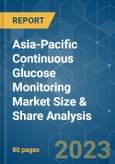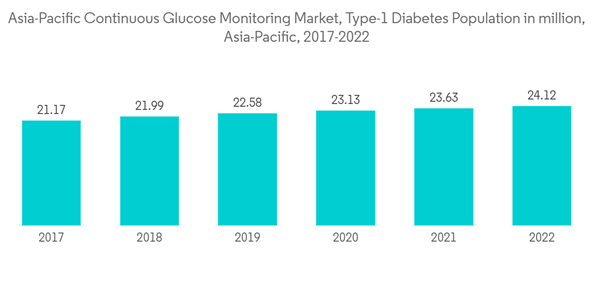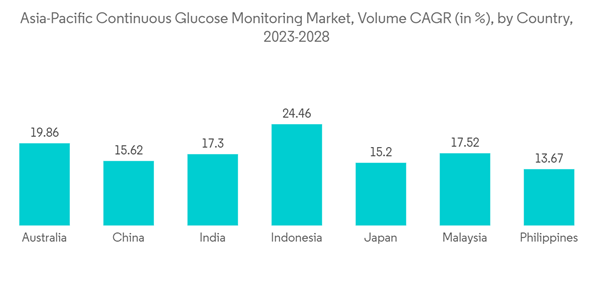The Asia-Pacific Continuous Glucose Monitoring Market size is estimated at USD 1 billion in 2023, and is expected to reach USD 2.01 billion by 2028, growing at a CAGR of 11.74% during the forecast period (2023-2028).
The COVID-19 pandemic positively impacted the Asia-Pacific Diabetes Care Devices Market growth. Patients with diabetes, infected with COVID-19 may experience elevated blood glucose, abnormal glucose variability, and diabetic complications. The prevalence of diabetes in people with COVID-19 caused a significant increase in severity and mortality of COVID-19 in people with either type 1 (T1DM) or type 2 diabetes mellitus (T2DM), especially in association with poor glycemic control. While new-onset hyperglycemia and new-onset diabetes (both T1DM and T2DM) have been increasingly recognized in the context of COVID-19 and have been associated with worse outcomes. To avoid aggravation, a patient's blood glucose should be monitored regularly, which has underlined the importance of blood glucose monitoring devices. Pandemic emergency has created a rise in remote care from both patients and providers and removed many long-standing regulatory barriers.
According to International Diabetes Federation (IDF), 90 million adults (20-79) are living with diabetes in the IDF South-East Asia (SEA) Region in 2021. This figure is estimated to increase to 152 million by 2045 and 206 million adults (20-79) are living with diabetes in the IDF Western Pacific Region in 2021 which is estimated to increase to 260 million by 2045. The main diagnosis for diabetes patients is imbalances in blood glucose levels, which are not in compliance with the standard blood glucose levels. The general lab diagnostic tests can only help to diagnose the disease by physicians. Patients with more fluctuations in glucose levels need to get it checked every day. Patients administering insulin need to check their blood glucose levels frequently, adjust the doses of insulin, or change the medication, if necessary.
The rate of newly diagnosed Type 1 and Type 2 diabetes cases is seen to increase, mainly due to obesity, unhealthy diet, and physical inactivity. The rapidly increasing incidence and prevalence of diabetic patients and healthcare expenditure in developed countries are indications of the increasing usage of diabetic care products. Moreover, the increasing adoption of insulin delivery devices and the rising prevalence of diabetes are driving the market growth. Leading manufacturers are focusing on technological innovations and the development of advanced products to gain a substantial share of the market.
Furthermore, the current continuous glucose monitoring devices can either display the trends in blood glucose levels by downloading the data or give a real-time picture of glucose levels through receiver displays. Continuous glucose monitoring devices are becoming cheaper with the advent of new technologies, like cell phone integration, which is likely to drive the segment. The market players are adopting various strategies and innovations to increase market share. For instance, In July 2021, Terumo Corporation announced the launching the Dexcom G6 continuous glucose monitoring (CGM) system in Japan. U.S.-based Dexcom manufactures the Dexcom product, and Terumo holds the exclusive distribution agreement of Dexcom Products in Japan.
The Asia-Pacific region has the two highest diabetes populations in the world. With the increasing type-1 diabetes population in the area, the segment is expected to grow over the forecast period.
China stands third in number among the countries with the highest diabetes population. Type 2 diabetes (T2D) has rapidly increased over the past decade, becoming a leading public health challenge in China. The increasing number of diabetes patients drives the growth in the Chinese diabetic market, the increase in high-calorie diets, and sedentary lifestyles. This has led the country to record the highest number of diabetes patients globally, totaling 129 million people in 2021, roughly 8.5% of the population. About 129 million people were suffering from diabetes mellitus in 2021, with a prevalence of 10% among adults. Of the 129 million diabetic patients, 12.75 million were Type 1 patients, and 116.85 million were Type 2 patients.
Therefore, owing to the factors above, the growth of the studied market is anticipated in the Asia-Pacific Region.
The COVID-19 pandemic positively impacted the Asia-Pacific Diabetes Care Devices Market growth. Patients with diabetes, infected with COVID-19 may experience elevated blood glucose, abnormal glucose variability, and diabetic complications. The prevalence of diabetes in people with COVID-19 caused a significant increase in severity and mortality of COVID-19 in people with either type 1 (T1DM) or type 2 diabetes mellitus (T2DM), especially in association with poor glycemic control. While new-onset hyperglycemia and new-onset diabetes (both T1DM and T2DM) have been increasingly recognized in the context of COVID-19 and have been associated with worse outcomes. To avoid aggravation, a patient's blood glucose should be monitored regularly, which has underlined the importance of blood glucose monitoring devices. Pandemic emergency has created a rise in remote care from both patients and providers and removed many long-standing regulatory barriers.
According to International Diabetes Federation (IDF), 90 million adults (20-79) are living with diabetes in the IDF South-East Asia (SEA) Region in 2021. This figure is estimated to increase to 152 million by 2045 and 206 million adults (20-79) are living with diabetes in the IDF Western Pacific Region in 2021 which is estimated to increase to 260 million by 2045. The main diagnosis for diabetes patients is imbalances in blood glucose levels, which are not in compliance with the standard blood glucose levels. The general lab diagnostic tests can only help to diagnose the disease by physicians. Patients with more fluctuations in glucose levels need to get it checked every day. Patients administering insulin need to check their blood glucose levels frequently, adjust the doses of insulin, or change the medication, if necessary.
The rate of newly diagnosed Type 1 and Type 2 diabetes cases is seen to increase, mainly due to obesity, unhealthy diet, and physical inactivity. The rapidly increasing incidence and prevalence of diabetic patients and healthcare expenditure in developed countries are indications of the increasing usage of diabetic care products. Moreover, the increasing adoption of insulin delivery devices and the rising prevalence of diabetes are driving the market growth. Leading manufacturers are focusing on technological innovations and the development of advanced products to gain a substantial share of the market.
Asia-Pacific Continuous Glucose Monitoring Market Trends
The sensors Segment is having the highest market share in Asia-Pacific Continuous Glucose Monitoring Market.
Continuous glucose monitoring sensors use glucose oxidase to detect blood sugar levels. Glucose oxidase converts glucose to hydrogen peroxidase, which reacts with the platinum inside the sensor, producing an electrical signal to be communicated to the transmitter. Sensors are an essential part of continuous glucose monitoring devices. Technological advancements to improve the accuracy of the sensors are expected to drive segment growth during the forecast period. Continuous glucose monitoring has become a popular alternative to the portable finger-prick glucometers available in the market for the convenience of diabetic patients. According to a research study by Ziyi Yu et al., published in IOP Science Journal in March 2021, a large variety of promising glucose-sensing technologies, from traditional electrochemical-based glucose sensors to novel optical and other electrical glucose sensors, has been developed which shows a positive impact on the market growth.Furthermore, the current continuous glucose monitoring devices can either display the trends in blood glucose levels by downloading the data or give a real-time picture of glucose levels through receiver displays. Continuous glucose monitoring devices are becoming cheaper with the advent of new technologies, like cell phone integration, which is likely to drive the segment. The market players are adopting various strategies and innovations to increase market share. For instance, In July 2021, Terumo Corporation announced the launching the Dexcom G6 continuous glucose monitoring (CGM) system in Japan. U.S.-based Dexcom manufactures the Dexcom product, and Terumo holds the exclusive distribution agreement of Dexcom Products in Japan.
The Asia-Pacific region has the two highest diabetes populations in the world. With the increasing type-1 diabetes population in the area, the segment is expected to grow over the forecast period.
China is Expected to Dominate the Asia-Pacific Continuous Glucose Monitoring Devices Market.
China dominates around 56% of the Asia-Pacific Insulin Infusion Pump Market among the Asia-Pacific countries. This is mainly due to the high diabetes prevalence in this country. China records the highest healthcare expenditure in the Asia-pacific region. According to the National Bureau of Statistics of China, MOH (China), in 2021, China’s expenditure on health and hygiene was Yuan 1,920.5 billion. Expenditure includes government, collective, and private out-of-pocket spending on health care. Health insurance is voluntary in China, but the share of the population being covered by basic health insurance has increased in the last ten years.China stands third in number among the countries with the highest diabetes population. Type 2 diabetes (T2D) has rapidly increased over the past decade, becoming a leading public health challenge in China. The increasing number of diabetes patients drives the growth in the Chinese diabetic market, the increase in high-calorie diets, and sedentary lifestyles. This has led the country to record the highest number of diabetes patients globally, totaling 129 million people in 2021, roughly 8.5% of the population. About 129 million people were suffering from diabetes mellitus in 2021, with a prevalence of 10% among adults. Of the 129 million diabetic patients, 12.75 million were Type 1 patients, and 116.85 million were Type 2 patients.
Therefore, owing to the factors above, the growth of the studied market is anticipated in the Asia-Pacific Region.
Asia-Pacific Continuous Glucose Monitoring Industry Overview
A significant share of the Asia-Pacific Continuous Glucose Monitoring Devices market study is held by CGM manufacturers concurrently with strategy-based M&A operations. These manufacturers continuously enter new markets to generate new revenue streams and boost existing ones. The market studied is consolidated with Dexcom, Abbott, and Medtronic, holding a high market share, followed by regional manufacturers accounting for a relatively smaller share.Additional Benefits:
- The market estimate (ME) sheet in Excel format
- 3 months of analyst support
Table of Contents
1 INTRODUCTION
4 MARKET DYNAMICS
5 MARKET SEGMENTATION
6 MARKET INDICATORS
7 COMPETITIVE LANDSCAPE
Companies Mentioned (Partial List)
A selection of companies mentioned in this report includes, but is not limited to:
- Abbott
- Dexcom
- Medtronics
- Eversense
- Ascensia
Methodology

LOADING...










